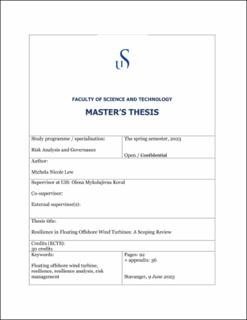| dc.description.abstract | Background
With climate change a looming global threat, offshore wind energy is a vital resource, and floating offshore wind turbines (FOWT) are essential to capture its full potential. Unfortunately, high operations and maintenance expenses pose an obstacle to widespread implementation of FOWT. Reducing maintenance needs by limiting FOWT damage or failure in harsh environments will undoubtedly contribute to lowering costs and to improving on-site personnel safety. Resilience, an important concept in the field of risk management, may be instrumental in achieving these goals.
Objective
The objective of this thesis was to develop a thorough understanding of how resilience is understood and its applications to FOWT design and operation. The following issues were of greatest interest: the degree to which FOWT literature addresses resilience, the various interpretations and definitions of resilience that are employed in FOWT research, and how those definitions of resilience are applied to FOWT. These issues and objectives led to the question this thesis sought to answer, in order to map the knowledge and potential gaps in FOWT resilience research: How is resilience understood and applied in the context of FOWT design and operation?
Methodology
In order to answer this research question, a scoping review was conducted, in which two databases – ScienceDirect and GreenFILE – were searched for sources that discussed resilience with respect to FOWT. In accordance with the JBI scoping review methodology, a search and screening strategy, including search terms and inclusion criteria, was determined in advance. The multi-stage screening process ensured that all relevant sources were included, and the entire process is described in such a way as to be transparent and repeatable.
Results
Thirteen sources, consisting of twelve articles and one report, were found to meet the inclusion criteria, and these were thematically analyzed in order to investigate the definitions/interpretations and applications of resilience to FOWT technology. Several trends were discovered among the included sources, including a dominant engineering perspective and a glaring lack of explicit resilience definitions. Despite this lack of definitions, however, several interpretations of resilience were found to be used among the thirteen sources, and these are discussed in depth. Furthermore, the various applications of resilience to FOWT were mapped in order to identify popular topics, and these findings were compared to trends noted elsewhere in the literature.
Conclusions
The results of this review provide valuable insight into the main interpretations of resilience that are used in relation to FOWT. They also provide a solid foundation for future work and for improvements in FOWT resilience research. Among these are the need for a clear definition of resilience in FOWT studies and the potential benefits that could come from the development of a risk management approach to enhance the strong engineering perspective within the field of FOWT resilience research. | |
